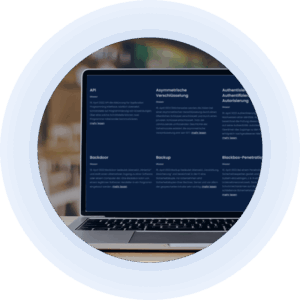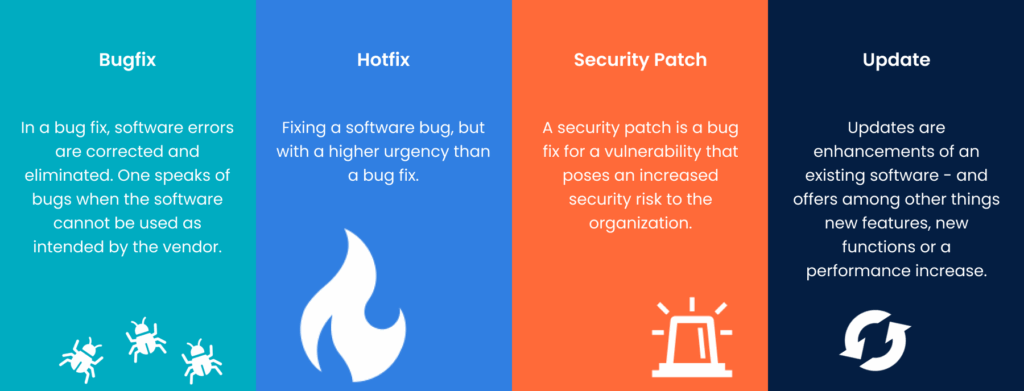
Das Wort „Patch“ kommt aus dem Englischen und bedeutet „Flicken“. Dies beschreibt, was sich dahinter verbirgt und die Funktionalität bereits sehr gut: wie ein Flicken ein Loch stopfen kann, schließen Patches Lücken in IT-Anwendungen. So werden Software- Anwendungen mit Patches aktualisiert, verbessert, erweitert oder auch korrigiert. Dies kann unter Umständen auch ohne Zutun des Anwenders geschehen.
Im Allgemeinen gibt es vier Kategorien von Patches: Bugfix, Hotfix, Sicherheits-Patch und das Update.
Bugfix: Bei einem Bugfix werden Softwarefehler korrigiert und beseitigt. Wenn ein Programm einen „Bug“ hat, kommt es zu Störungen oder Ausfällen und der Anwender kann die Software nicht wie von den Entwicklern beabsichtigt nutzen. Beispiele sind: Eine Funktion kann nicht mehr abgerufen werden, die Anmeldung funktioniert nicht oder das Programm schließt sich von selbst.
Hotfix: Bei einem Hotfix werden ebenfalls Softwarefehler behoben. Der einzige Unterschied zu einem Bugfix besteht in der Dringlichkeit, mit der der Fehler behoben wird. Daher kommt auch der Name „Hotfix“. Hier werden die englischen Wörter „hot“ und „fix“ kombiniert, die suggerieren, dass es sich bei dem Softwarefehler um ein kritisches Problem handelt, das schnell gelöst werden muss. Ein Beispiel könnte sein, dass die Beeinträchtigung dazu führt, dass es zu einer Häufung von Kundenbeschwerden kommt, dass der Fehler andere Anwendungen oder sogar weitere Produktionsbereiche betrifft.
Sicherheits-Patch: Ein Sicherheits-Patch ist eine Fehlerbehebung für eine Sicherheitslücke, die ein erhöhtes Sicherheitsrisiko für das Unternehmen darstellt. Dies ist der Fall, wenn kriminelle Akteure bestehende Schwachstellen in einer Software ausnutzen und sich Zugang zum System verschaffen können, um bösartigen Code auszuführen und so das gesamte System zu kompromittieren. Zero-Day-Schwachstellen sind besonders tückisch. In diesen Fällen wissen Cyberkriminelle von der bestehenden Schwachstelle und nutzen sie aus, noch bevor der Softwarehersteller überhaupt über die Existenz der Sicherheitslücke informiert ist und somit auch bevor ein Sicherheits-Patch für die Benutzer zur Verfügung gestellt werden kann. Bekannte Zero-Day-Schwachstellen sind z. B. die Sicherheitsschwachstellen rund um den Microsoft Exchange Server. Auch hier haben Angreifer die Schwachstellen bereits ausgenutzt, bevor Microsoft selbst von den Lücken wusste.
Updates: Updates sind Erweiterungen und Erneuerungen einer bestehenden Software. Anders als bei den zuvor genannten Beispielen geht es hier nicht um die Behebung eines Fehlers oder einer Fehlfunktion, sondern darum, dem Nutzenden Weiterentwicklungen bzw. Optimierungen der Software zur Verfügung zu stellen – z. B. durch neue Features, neue Funktionen oder einfach einer Leistungssteigerung.
Patches und Updates bergen viele Vorteile. Updates sorgen oft für eine verbesserte Leistung. Die Arbeit und Handhabung wird oft erleichtert und optimiert. Außerdem wird sichergestellt, dass die Kompatibilität mit anderen Software-Anwendungen oder Hardware-Elementen erhalten bleibt.
Vor allem aber spielt der Sicherheitsaspekt eine große Rolle. Wenn Bugs und Fehler nicht rechtzeitig behoben werden, besteht die Gefahr, dass sie anfälliger für Viren, Trojaner und andere Malware (Schadsoftware) werden. Sicherheits-Patches sollten immer umgehend installiert werden. Nur so kann sichergestellt werden, dass keine kriminellen Akteure diese Lücken ausnutzen, um sich unbefugt Zugang zu den Systemen zu verschaffen.

The word „patch“ comes from English and means „flick“ or „patch.“ This describes its function quite well: just as a patch can cover a hole, patches close gaps in IT applications. Software applications are updated, improved, expanded, or corrected using patches. This can sometimes happen without the user’s intervention.
In general, there are four categories of patches: bug fix, hotfix, security patch, and update.
Bugfix: A bug fix corrects and removes software errors. When a program has a „bug,“ it leads to malfunctions or crashes, and the user cannot use the software as intended by the developers. Examples include: a function no longer being accessible, login not working, or the program closing on its own.
Hotfix: A hotfix also addresses software errors. The only difference from a bug fix lies in the urgency of fixing the error. Hence the name „hotfix“ – combining the English words „hot“ and „fix“ to suggest that this is a critical issue that needs to be resolved quickly. An example might be an impairment that leads to a high number of customer complaints or affects other applications or even production areas.
Sicherheits-Patch: A security patch addresses a vulnerability that poses a heightened security risk to the company. This is the case when criminal actors exploit existing vulnerabilities in software to gain access to systems, execute malicious code, and compromise the entire system. Zero-day vulnerabilities are particularly tricky. In such cases, cybercriminals are aware of the vulnerability and exploit it even before the software vendor knows it exists – and thus before a patch is made available to users. Known zero-day vulnerabilities include those affecting Microsoft Exchange Server. In these cases, attackers exploited the weaknesses before Microsoft was even aware of them.
Updates:
Updates are extensions and renewals of existing software. Unlike the above examples, updates are not primarily about fixing errors or malfunctions but about providing users with improvements and new developments – for example, new features, additional functions, or performance enhancements.
Patches and updates offer many benefits. Updates often improve performance and make applications easier and more efficient to use. They also ensure continued compatibility with other software applications or hardware components.
Above all, security plays a crucial role. If bugs and errors are not fixed in time, systems become more vulnerable to viruses, trojans, and other malware. Security patches should always be installed immediately. Only then can it be ensured that cybercriminals do not exploit these gaps to gain unauthorized access to systems.
Note:
Perseus offers all companies using the Cybersecurity Online Portal a threat newsletter that provides information on current security vulnerabilities.